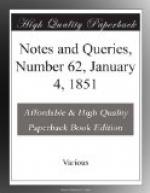“The History of the
Sevarambians, a people of the south continent, in
five parts, containing, &c.
Translated from the Memoirs of Capt. Siden,
who lived fifteen years amongst
them.”
The work is included in the collection of Voyages Imaginaires, tom. v., where the editor speaks of the distinguished place which it holds among the fictions of that class; but he says that its authorship was unknown or uncertain. An account of another fictitious voyage to the Terra Australis, with a description of an imaginary people, published in 1692, may be seen in Bayle’s Dict., art. SADEUR, Voyages Imaginaires, tom. xxiv.
According to the account given by Marchand, Vairasse began life by serving in the army in Piedmont, and he afterwards studied the law. Subsequently he went to England, where he is stated to have attempted to penetrate the intrigues of the court, and to discover the maxims of the English Government. In 1665, he was in the ship commanded by the Duke of York against the Dutch; and some years afterwards, having been regarded as an accomplice in the designs of a public minister (apparently Lord Clarendon), he was forced to retire with him, and follow him to Paris. He re-entered the military service, and was with the French army which invaded Holland in 1672. Afterwards he taught English and French at Paris; he likewise published a French Grammar, and an abridgment of it in the English language (1683). He was of the reformed religion.
It is possible that Vairasse’s visit to England may have been connected with his religion. He appears, during his residence here, to have acquired the English language; but it is difficult to understand what are the designs of Lord Clarendon in which he was an “accomplice.” Lord Clarendon’s exile took place in 1667; which hardly accords with the expression “some years” after 1665. No person of the name of Vairasse is mentioned as having accompanied Lord Clarendon in his banishment.
The first part of the History of the Sevarambians was published in English in 1675, two years before the French edition of the first part. The second parts were published at London and Paris in the same year. Even if Vairasse did not leave England with Lord Clarendon, he had left it before the year in which the first part of this {6} work appeared in English: for he is stated to have been with the French army in Holland in 1672. It is therefore difficult to account for the publication of the English version of the History of the Sevarambians before its publication in France, upon the assumption that Vairasse was the author. The writer of the life of Vairasse (art. ALLAIS) in the Biographical Dictionary of the Society of Useful Knowledge thinks that he may have been only the translator: but the facts collected by Marchand show that he claimed the authorship; and there is no trace of its composition by any Englishman. Besides, its prior publication in England is just as inexplicable upon the assumption of his being the translator, as upon that of his being the author.




